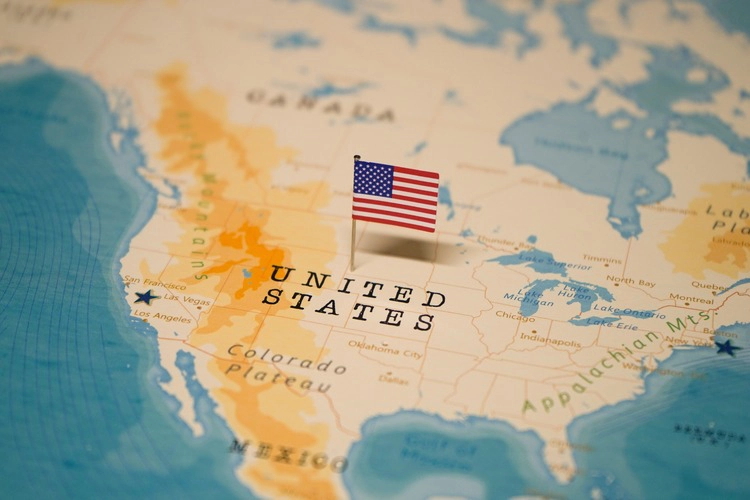Recent polls show an almost near-tie between Harris and Trump. Image: Shutterstock
Why remote work, internal migration and movements into America may reshape the election map in theupcoming presidential race
By Victoria Heath
More than 65 million Americans have cast their ballot ahead of Tuesday’s US presidential election between the Republicans and Democrats.
With the election already underway, the outcome of the vote between Trump and Harris, and how the election map will appear, remains uncertain.
 The race towards presidency between Trump and Harris draws closer, but migration adds a further level of complexity to predicting voter trends. Image: Shutterstock
The race towards presidency between Trump and Harris draws closer, but migration adds a further level of complexity to predicting voter trends. Image: Shutterstock
Many factors will impact the decision of particular states in their voting. But the movement of individuals into America, as well as migration between states themselves, seems to have already reshaped – or at least begun to alter – the voting tendencies of several states in the country.
But how exactly does migration affect the election map? And which states are undergoing changes to their political allegiances due to migration?
The rise of remote work
Due to an increase in the opportunities for remote work since the pandemic, many Americans have moved around the country in ways that traditional in-person office jobs didn’t previously allow. Unsurprisingly, these geographical movements are likely to have impacts in the political strata in more ways than one and are affecting the election map.
Since 2020, the overall trend of those moving across states is from blue (Republican) to red (Democrat). States such as New York and California are being forgone by remote workers for Florida and Texas: not only due to geographic flexibility, but cheaper living costs and affordability.
Enjoying this article? Check out our related reads:
Arizona, Georgia and Pennsylvania have also seen an influx in workers from left-leaning areas, greater than the number of those relocating from red counties or areas that have unclear political preferences.
 Remote work has meant workers in bustling cities like New York are able to move to traditionally red-leaning states including Florida. Image: Shutterstock
Remote work has meant workers in bustling cities like New York are able to move to traditionally red-leaning states including Florida. Image: Shutterstock
Recent analysis has found a relationship between the number of remote work opportunities and the left-leaning status of a state: the more left-leaning, the great number of remote job posting opportunities for that area. This makes it more feasible for Democrat workers to live further from their workplace, potentially shifting the voter demographic in the areas or states they move to.
It’s worth pointing out that those moving to new states could be influenced by the behaviours and political decisions of those around them, so that their initial political stance is changed.
But if relocated citizens do stick to their original political preference, this could have significant impacts for the new regions they move to and ultimately the composition of the election map in the 2024 US presidential election.
Purple states turning more purple
Named so due to having no clear-cut voter trend toward either the red Republicans or the blue Democrats, ‘purple’ states in the US are becoming even more undecided due to migration.
In particular, Arizona’s growing Latino population – especially in Phoenix – means that the state’s traditionally conservative voting stance is challenged by more Democratic viewpoints, shifting the appearance of the election map.
So strong is Phoenix’s hold on Arizona’s overall voting stance that electoral outcomes are often determined by the city and its surrounding suburbs, such as Maricopa County – which comprises 59 per cent of the state’s registered voters. This clearly emphasises the impact that migrating communities could have on the overall voting decision of a state.
Early voting in Phoenix, Arizona – one of the swing states of the US. Video: Africa News
Rural areas of Arizona still favour the Republican party, but the Latino community – making up one in four citizens in the state – have offered a more Democratic-leaning stance, positioning Arizona now as a swing state which both Republicans and Democrats will be vying for in the upcoming election.
Wisconsin, too, oscillates between red and blue, with the recent migration trends of younger populations into cities including Madison and Milwaukee shifting their political allegiances. Known as a swing state, Wisconsin previously voted Democratic from 1988 to 2012, shifting to Republican in 2016 and back to Democratic during the 2020 US elections.
Again, the constant flux between both parties makes it difficult to predict who voters will choose in the upcoming election.
Georgia and North Carolina are also examples of swing states that have seen a rise in migration, which could affect the overall vote of each state. Since 2020, an estimated 366,000 new residents have moved to North Carolina, with migration from other US states accounting for 89 per cent of this growth.
The top states to move from into North Carolina were Florida (36,000), New York (33,000), Virginia (30,000), South Carolina (23,000) and California (23,000), a mix between areas traditionally voting both Republican and Democrat.
As for the other 11 per cent of migration – occurring from other countries – Mexico (7,000), Honduras (2,400) and India (2,000) took the top spots. With such an influx of new residents, North Carolina’s political landscape may become more undecided and unclear ahead of the 2024 US presidential election too, along with several other states.
Swinging to red – and back again?
Some former swing states – namely Missouri and Indiana – have now become firmly red on the election map, in part due to migration of Republicans into the previously purple states. However, these states weren’t always in favour of Republicans in such a clear cut way.In the 2008 election, Obama won Indiana by one point.
 Voting in states such as Missouri and Indiana has fluctuated in recent years before settling as mainly Republican leaning. Image: Gino Santa Maria/Shutterstock
Voting in states such as Missouri and Indiana has fluctuated in recent years before settling as mainly Republican leaning. Image: Gino Santa Maria/Shutterstock
Other states have seen similar moves. Florida voted for Obama in 2008 and 2012, then swung to red in its vote for Trump by 2016 – who won by just 1.2 points.
Shifts in what states are known as ‘swing states’ is an ever-changing dynamic, one that depends on a range of factors that undeniably include both migration between US states as well as movement into the US from other countries.
And as states may move toward red now, that is certainly not a guaranteed permanent shift to the Republican party. Calculations made this year show that Florida is becoming left-leaning in the lead-up to the Harris-Trump election.
Amidst the plethora of changes that migration brings, one thing is clear: the evolving population of the United States seems to be redefining the traditions of its political landscape, and migration adds a further layer of complexity to deciding the long-awaited result for America’s next president.
Source link : http://www.bing.com/news/apiclick.aspx?ref=FexRss&aid=&tid=672ada739e274e5db1f544c3ac6b8500&url=https%3A%2F%2Fgeographical.co.uk%2Fnews%2Fhow-the-election-map-in-the-us-is-changing&c=8890391727705881013&mkt=en-us
Author :
Publish date : 2024-11-05 13:47:00
Copyright for syndicated content belongs to the linked Source.









